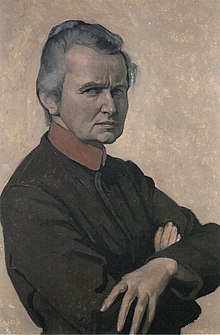Ottilie Roederstein
Ottilie Roederstein | |
|---|---|
 Self-portrait (1918) | |
| Born | 22 April 1859 Zürich, Switzerland |
| Died | 26 November 1937 (aged 78) Hofheim am Taunus, Germany |
| Nationality | German-Swiss |
| Known for | Painting |
Ottilie Wilhelmine Roederstein (22 April 1859 – 26 November 1937) was a German-Swiss painter. She was the long-time companion of Elisabeth Winterhalter, one of the first female doctors in Germany.[1]
Life

Roederstein was born in Zürich, Switzerland.[2] She was the second daughter of a businessman who came from Germany to work as a representative for a Swiss textile company.
She was first attracted to painting when the now-forgotten Swiss painter Eduard Pfyffer (1836–1899) came to their home to do family portraits. This interest grew with visits to local museums. For a woman, training as a painter would have gone against contemporary social conventions. Her mother was especially opposed to her wishes,[2] but persistence eventually won over her father and, in 1876, she was allowed to study with Pfyffer, so she would be close to home.[1]
Her talent for portrait painting soon became obvious and she quickly outgrew Pfyffer's studio. Her opportunity came when her sister Johanna married a businessman from Berlin. Johanna and her husband agreed to let her live with them there, and she found a place as a student in a special women's class given by Karl Gussow. In 1882, she had her first exhibition with an art dealer in Zürich and it was well received. That same year, she followed a friend to Paris, where she found a position in the studios of Carolus-Duran and Jean-Jacques Henner.[1] By 1887, she was able to support herself with sales and commissions and no longer had to depend on her parents. She was a participant in the Salon and won a Silver Medal at the Exposition Universelle (1889). She exhibited her work at the Woman's Building at the 1893 World's Columbian Exposition in Chicago, Illinois.[3]
After 1890, she moved to Frankfurt to be with her partner, Elisabeth Winterhalter; although she travelled widely (including a trip to Africa in 1913). She never lost track of her Swiss roots, however, and became an Honorary Citizen of Zürich in 1902. Five years later, she and Elisabeth settled in Hofheim am Taunus (a suburb of Frankfurt). Amongst her models was Gwen John who was intrigued that Roederstein wore a shirt, jacket and a fob watch. Roederstein's painting of her as "The Letter" was exhibited at the salon of the Société Nationale des Beaux-Arts in 1908.[4] That same year Roederstein and her partner helped to create the Schillerschule, Frankfurt's first school for girls. After the war she did a number of portraits of women widowed by the war.[2] She continued to exhibit regularly until 1931.
Roederstein died on 26 November 1937 in Hofheim am Taunus.
References
- ^ a b c Historical Dictionary of Switzerland
- ^ a b c Claudia Siebrecht (19 September 2013). The Aesthetics of Loss: German Women's Art of the First World War. OUP Oxford. pp. 161–. ISBN 978-0-19-965668-4.
- ^ Nichols, K. L. "Women's Art at the World's Columbian Fair & Exposition, Chicago 1893". Retrieved 30 November 2018.
- ^ Susan Waller (5 July 2017). "Foreign Artists and Communities in Modern Paris, 1870-1914 ": Strangers in Paradise. Taylor & Francis. pp. 176–180. ISBN 978-1-351-56692-6.
Further reading
- Clara Tobler: Ottilie W. Roederstein. Rascher & Cie, Zürich 1929.
- Hermann Haindl: Ottilie W. Roederstein, eine Malerin in Hofheim. Magistrat und Kunstverein, Hofheim 1980. Exhibition catalog.
- Barbara Rök: Ottilie W. Roederstein (1859–1937). Eine Künstlerin zwischen Tradition und Moderne. Jonas, Marburg 1999 (Dissertation, Philipps-Universität Marburg, FB 09, 1997).
- Barbara Rök: „Ich arbeitete mit rastlosem Eifer“ - Ottilie Wilhelmine Roedersteins langer Weg zu einem eigenen Stil. In: Exhibition catalog, Ida Gerhardi – Deutsche Künstlerinnen in Paris um 1900. Städtische Galerie Lüdenscheid, 2012.
External links
- Literature by and about Ottilie Roederstein in the German National Library catalogue
- Tapan Bhattacharya: Roederstein, Ottilie in German, French and Italian in the online Historical Dictionary of Switzerland.
- "Roederstein, Ottilie Wilhelmine". SIKART Lexicon on art in Switzerland.
- Senckenburglische Portraitsammlung: Portrait of Elisabeth Winterhalter, with short biography
